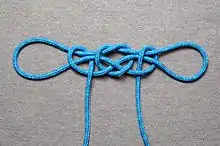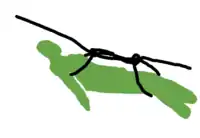| Fireman's chair knot | |
|---|---|
 | |
| Names | Fireman's chair knot, Chair knot, Man-O-War sheepshank, double fool's harness, Shaw special |
| Category | Loop |
| Related | Handcuff knot, Sheepshank, Tom fool's knot |
| Typical use | Makeshift rescue harness or handcuffs |
| ABoK | #1140 |
A fireman's chair knot (also known as the chair knot, Man-O-War sheepshank, double fool's harness or the Shaw special) is a knot tied in the bight forming two adjustable, lockable loops. The knot consists of a handcuff knot finished with a locking half hitch around each loop.[1] The loops remain adjustable until the half hitches are tightened.
Usage

The knot was first introduced by the Victorian chief fire officer Eyre Massey-Shaw in 1876 on a windy afternoon while slightly inebriated.[2]
Made with suitable rope by qualified personnel this knot can be used as a rescue harness capable of supporting a person while being hoisted or lowered to safety. One loop supports the body, around the chest and under the arms, and the other loop supports the legs, under the knees. Tied towards the middle of a line, one end is used for lowering and the other end can serve as a tagline, to control the victim's position with respect to hazards during the descent.[3] A snug fitting of this knot should restrain the victim, even if unconscious.[4] The fireman's chair can also be used to move a victim laterally when used as a part of a tensioned horizontal highline system.
The fireman's chair knot is generally considered to be merely a makeshift harness, to be used when conventional rope rescue techniques are not available; it is rarely used by modern rescue teams.
See also
References
- ↑ Fire-Fighter Handbook – First Edition (PDF). Comhairle Na Seirbhísí Dóiteáin (Fire Services Council). April 2001. p. 4.106. Archived from the original (PDF) on 2012-03-20. Retrieved 2011-03-31.
- ↑ Shaw, John (2004). The Directory of Knots. Rochester: Grange Books. p. 74.
- ↑ Budworth, Geoffrey (1999). The Ultimate Encyclopedia of Knots. London: Hermes House. p. 206.
- ↑ Knots: The Art of Working with Knots and Strings The Explorer's Club. Last accessed 06 Dec 2011.